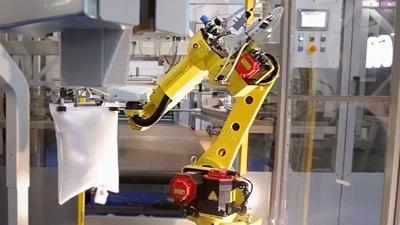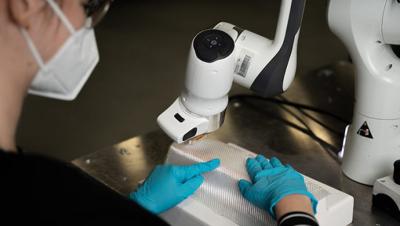Interview with Michael Fraede, Robotextile

Michael Fraede (Source: Robotextile)
Over the course of many years, the textile industry has shifted production abroad. About 70% of textiles are currently produced in Asia. However, this has also partly meant that the understanding of the supply chain from fiber to fabric to finished product, including all accessory materials and logistics, has gradually been lost.
Currently, the biggest challenges in the textile industry include the demand for more transparency in the supply chains and supply bottlenecks, but also a shortage of skilled workers and rising labor costs. How do you counter this?
Today, we see the same issues and challenges in the domestic textile industry, which is divided into apparel and technical textiles, as in the German automotive supplier industry of the 1980s and 1990s. At that time, an emotional decision had to be made whether, on one hand, to relocate production with hundreds of jobs to Eastern Europe (because of the low hourly wage of the workers), or, on the other hand, to automate in a sensible and stable way at the German site. At the time, more was relocated than automated. 10 years later, most of the production was brought back, partially automated, and German jobs were recreated. The disadvantages of the relocation were greater than the advantages of the favorable hourly wage. The domestic textile industry can learn from this.
In my numerous discussions in the German textile industry, however, the lack of workers in the low-wage sector as well as the shortage of skilled workers is a major problem. This can only be solved effectively through automation.
Today, we see the same issues and challenges in the domestic textile industry, which is divided into apparel and technical textiles, as in the German automotive supplier industry of the 1980s and 1990s. At that time, an emotional decision had to be made whether, on one hand, to relocate production with hundreds of jobs to Eastern Europe (because of the low hourly wage of the workers), or, on the other hand, to automate in a sensible and stable way at the German site. At the time, more was relocated than automated. 10 years later, most of the production was brought back, partially automated, and German jobs were recreated. The disadvantages of the relocation were greater than the advantages of the favorable hourly wage. The domestic textile industry can learn from this.
In my numerous discussions in the German textile industry, however, the lack of workers in the low-wage sector as well as the shortage of skilled workers is a major problem. This can only be solved effectively through automation.
Can we bring textile production back to Germany and Europe?
Everyone is currently talking about nearshoring and re-shoring. This can be compared with the discussions surrounding Industry 4.0 10 years ago. It took around 5-10 years for German industry and the manufacturing SME sector to make a useful start with its digitalization. Effective textile re-shoring will also take a similar amount of time. Nevertheless, it is the right strategy and must be pursued consistently and in the long term. Above all, the 40% unnecessary overproduction of fast fashion must stop, the burning of 1.5 billion tons of CO2 on the textile container freighters from Asia to Europe, and the burning of 100,000 tons of old clothing in Chile in the Atacama deserts must come to an end. That is why the Supply Chain Due Diligence Act has been in place since January 1, 2023.
How can this be done?
The answer can only lie in digitalization, automation and individualization. The consumer wants personalized and valuable products quickly and “inexpensively”. This can be achieved close to the customer – i.e. small and flexible batch sizes, produced according to demand, and delivered quickly. Digitalized micro-factories can be efficiently controllable and well utilized. The additional costs are offset by the short delivery distances and avoidance of pointless overproduction (dead stock and product disposal).
It is important to know that in Germany we once had 2 million jobs in the textile industry, it was the second largest industry in Germany. Today we still have 140,000 textile jobs in Germany and have greatly reduced the expertise. This needs to be rebuilt and enriched with mechatronics knowledge. Robots alone can't fix that.
To what extent can automation and robotics be sustainable?
Automation reduces the resources used in terms of raw materials, energy, materials, transport, personnel, space and infrastructure. The value streams in manufacturing and logistics are optimized. Waste is avoided. Everything is used in a more optimized and plannable way. Costs and utilization become much more transparent, investments can be used flexibly. Rental models for machinery and equipment become financially feasible.
As Robotextile, we approached the topic of textile gripping in a completely different way. We measured and tested about 30 different textiles for gripper suitability. Automation companies have hardly ever done this before, and textile specialists do not know which parameters are important for gripping. We have closed this gap, and have assigned 30 different textiles to the 6 gripper technologies according to feasibility: Air flow (Coanda), rubber pinch roller, tape point gripper, silicone parallel finger, needle gripper, vacuum gripper.
Textile waste and overproduction are global problems. Do you have ideas on how these challenges can be tackled?
The issue of textile waste and overproduction can definitely (almost only) be solved in domestic production through modern machinery, digitalization and optimization of resources through automation. Here, we can have the processes, networks and optimized digitalization, and proximity to customers under control. Therein still lies a huge potential to bring the textile industry into the modern era, and to produce optimized according to demand.
The interview was conducted by the TextileTechnology Team with Michael Fraede, Managing Director of Robotextile GmbH, Dormettingen/Germany.



